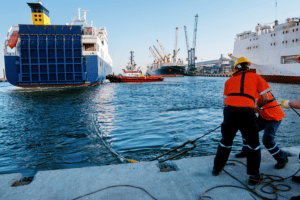Maritime injuries are usually associated by most people with accidents that occur while out to sea, yet a multitude of maritime workers are injured while performing shore-based duties. Although there are certain requirements needed in order for injured shore-based workers to receive benefits and compensation, general maritime law sets regulations that protect these workers as well.

Types of Maritime Shore-Based Accidents
One of the most common types of shore-based accidents occurs when workers are loading and unloading cargo from vessels. These types of accidents can happen for a variety of reasons, including improper safety training, cargo that’s stowed incorrectly, working on slippery decks, and defective conveyor belts.
Crane accidents are also a common cause of shored-based accidents and remain a major problem across the nation. When these types of accidents occur, the results can often be fatal. For instance, if an inexperienced crane operator makes a mistake or doesn’t see another crew member, a crane can easily strike the crew member. Additionally, faulty bundle straps that hold cargo on cranes can come undone, hitting workers in the vicinity.
Warehouse accidents are also common, and most often happen when an employer fails to provide adequate safety measures. For example, according to the Occupational Safety & Health Administration (OSHA), a worker was injured at a maritime facility while on a catwalk inside a warehouse facility. As he attempted to put a tripper device into its set position, the catwalk collapsed, resulting in the worker falling 35 feet below and landing on concrete. He died immediately. OSHA states that the accident could have been prevented had the worker’s employer made sure that the catwalk was in sound, operable condition with no defective parts. Maritime employers are legally required to regularly inspect all walking and working surfaces. If any defect or broken section is found, it must be repaired prior to anyone accessing the area.
Requirements for Shore-Based Workers
As previously mentioned, there are certain requirements that shore-based maritime workers must meet in order to be eligible for compensation. The Jones Act protects seamen who are injured while working in navigable waters, which unfortunately excludes many maritime workers, such as longshoremen and harbor workers. However, it’s important to mention that shore-based workers may still qualify for the Jones Act if their injuries occurred on an operable vessel that’s docked on navigable waters.
The good news, however, is that there are additional laws in place that protect those who are injured while not on navigable waters. The Longshore Harbor and Workers’ Compensation Act (LHWCA) was created to help shored-based workers who are injured with medical expenses and lost wages. LHWCA provides compensation to workers injured on navigable waters as well those injured at adjoining areas in which maritime activities are performed, such as loading and unloading vessel cargo, harbor work, building ships, and repairing ships.
However, workers may be excluded from the act if they are eligible for state workers’ compensation. In addition, United States contractor workers are excluded from LHWCA if they are injured while working outside of the nation. However, the Defense Base Act covers workers who are injured outside of the United States while working for the government. The Outer Continental Shelf Lands Act covers workers outside of the United States who are working for private companies that have operations on the nation’s Outer Continental Shelf.
Additional Resources
For more information regarding maritime rights and benefits and what you may qualify for, refer to our article Maritime Rights and Compensation.